Rhodesian Ridgeback Dog Breed Information
The Rhodesian Ridgeback stands out for its unique ridge of hair running along its back and a storied past that shapes its presence today. This breed was initially developed to hunt large game-like lions in Africa, but it has since evolved into a loving family pet. However, they still possess a muscular build and independent streak, making training challenging.
When we look at the Rhodesian Ridgeback, we see a breed that perfectly balances power with kindness. They require specific care due to their unique traits and history, and their popularity continues because of these qualities.
Understanding the Rhodesian Ridgeback means appreciating its journey from the African wilderness to being a beloved part of many homes.
Key Takeaways
- Rhodesian Ridgebacks were bred for hunting in Africa.
- They now make affectionate family dog.
- Training can be challenging due to independence.
Rhodesian Ridgebacks are known for their distinctive back ridge and rich history. Bred initially in Africa for tracking lions, they have become affectionate companions in domestic settings. Their muscular physique and independence can make obedience dog training a bit demanding.
These dogs balance robustness with gentleness, needing care that respects their heritage and qualities. Their enduring appeal is due to this balance.
The transition of the Rhodesian Ridgeback from wild hunter to household favorite demonstrates its adaptability and the affection it garners from owners.
Quick Facts
According to the American Kennel Club, the Rhodesian Ridgeback ranks as the 41st most popular dog breed; it has a lifespan of 10-12 years and features a unique ridge of hair on its back. This breed is part of the Hound Group and has a short, thick coat that can be light wheaten or red wheaten in color.
The Rhodesian Ridgeback originated in Southern Africa, bred to hunt and keep game at bay. Its impressive hunting skills make it a robust companion in the field.
Recognized by the American Kennel Club and associated with the Rhodesian Ridgeback Club of the United States, this breed adheres to strict standards for appearance and behavior. The Rhodesian Ridgeback is loyal and protective as a pet but needs consistent training due to its independence.
Prospective owners should be aware of health issues such as dermoid sinus, hip dysplasia, obesity, and gastric dilatation volvulus that can affect this breed.
Rhodesian Ridgeback Dog Breed Pictures
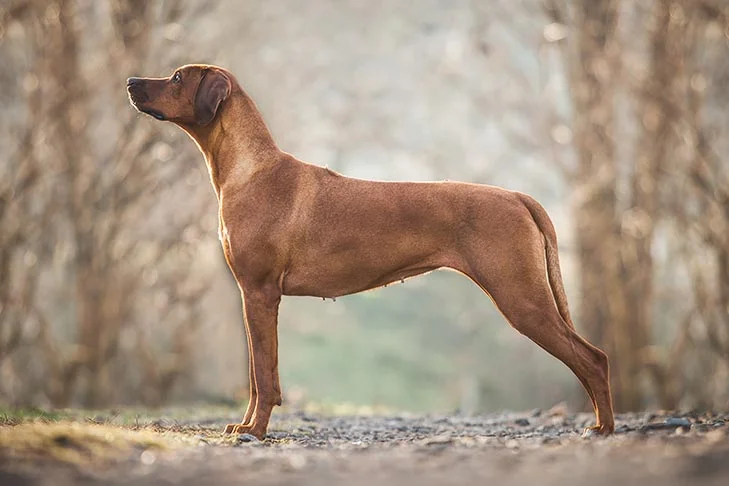
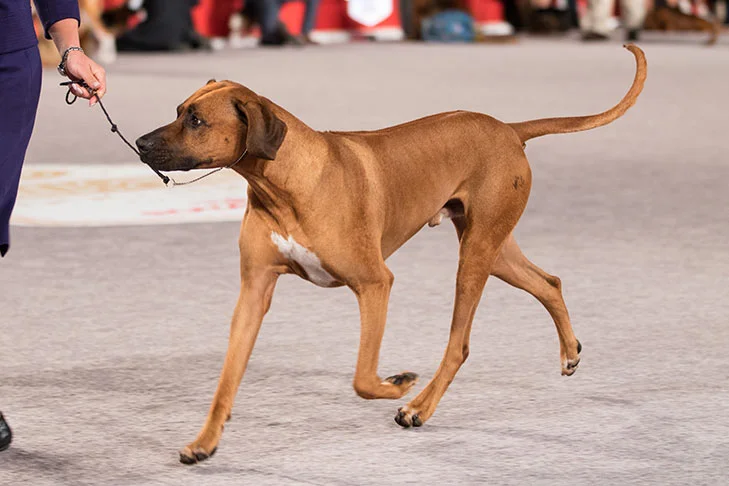
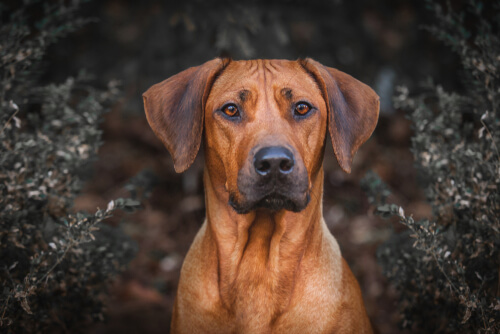
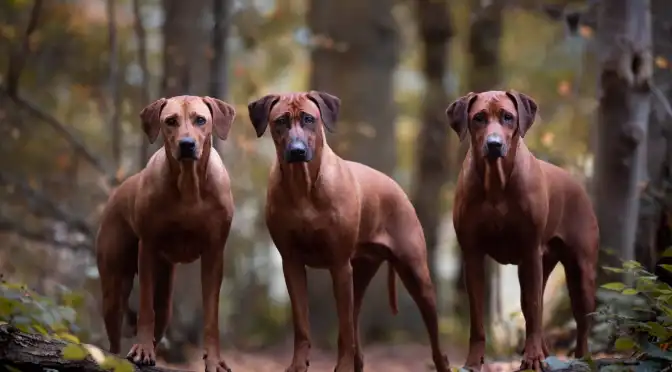
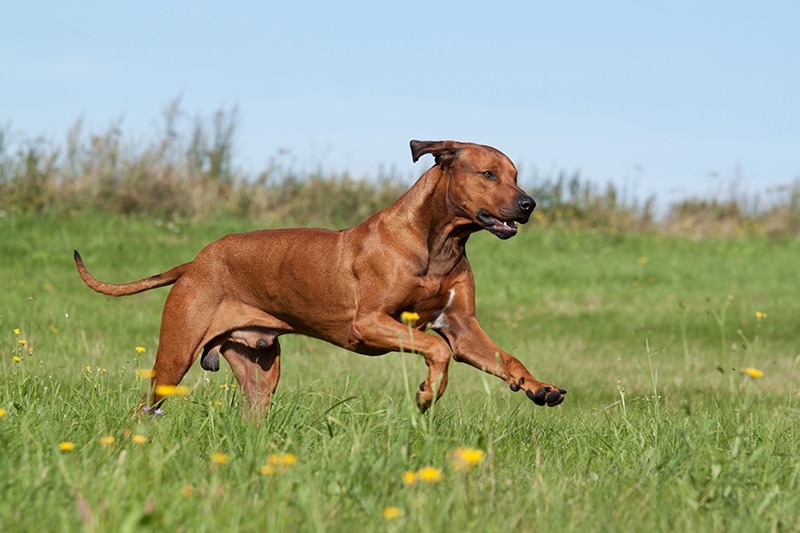
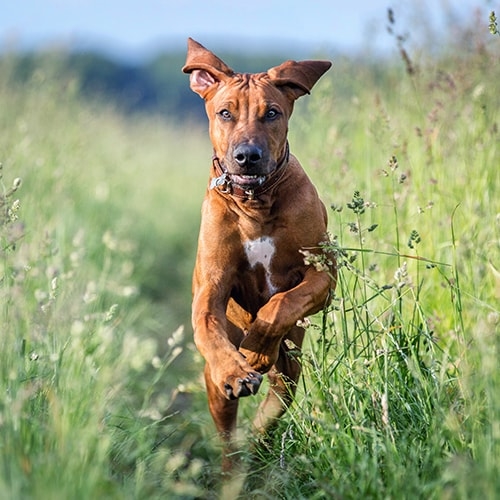
Overview
Building on its reputation as a robust hunting companion, the Rhodesian Ridgeback is a breed that commands a detailed exploration of its characteristics, origins, and the role it plays in the lives of its owners.
Hailing from Southern Africa, this large and powerful breed emerged from a strategic mix of European dogs and the ridged hunting dogs of the indigenous Khoikhoi people. With males averaging around 80 pounds and females 71 pounds, the Rhodesian Ridgeback showcases a muscular physique complemented by a short, dense coat ranging from wheaten to red wheaten hues.
Renowned for their ability to track and corner lions, these dogs possess a legacy intertwined with savannah hunting. Despite their historical prowess as hunters, their contemporary status as vigilant family guardians is underpinned by their loyalty and protective instincts, necessitating adept training to manage their determined and independent temperament.
Distinctive Ridge Feature
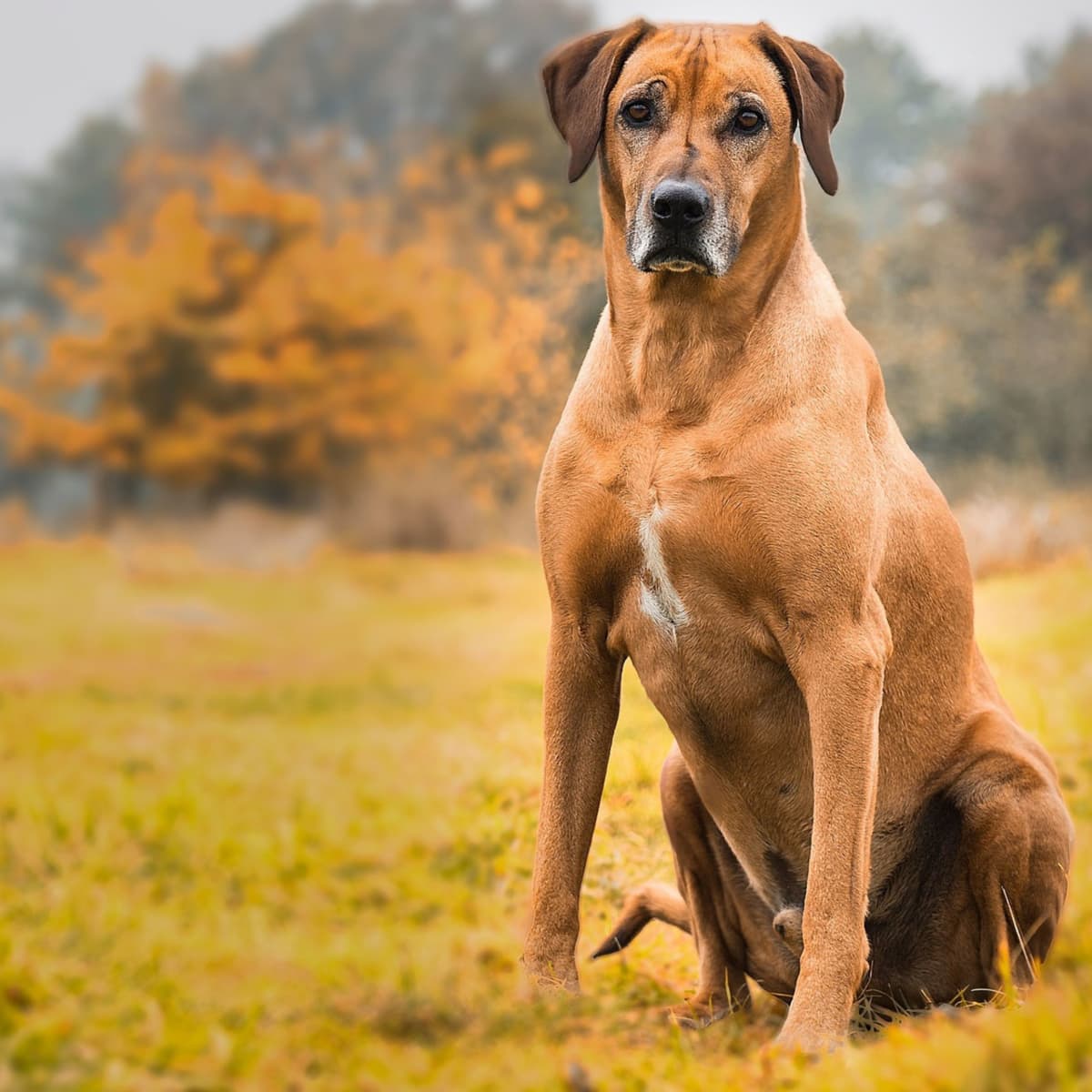
The Rhodesian Ridgeback stands out from other dog breeds thanks to a unique feature: a ridge of hair that runs along its back, growing the opposite way to its overall fur. This ridge isn’t just for looks; it’s a signature trait passed down from the dogs of the Khoikhoi people. The ridge is created by two hair swirls, called ‘crowns,’ which can differ in form and size.
| Ridge Feature | Description |
|---|---|
| Origin | Inherited from Khoikhoi dogs |
| Function | Identifies the breed, adds to its look |
| Composition | Two swirls of hair mark the start of the ridge |
| Variation | Different ridge shapes and sizes |
| Crowns | Two swirls of hair mark the start of the ridge |
In Rhodesian Ridgebacks, the ridge is an essential part of the breed standard, which is closely examined for consistency in dogs that compete in shows.
Competitors in Dog Sports: Origins and Development
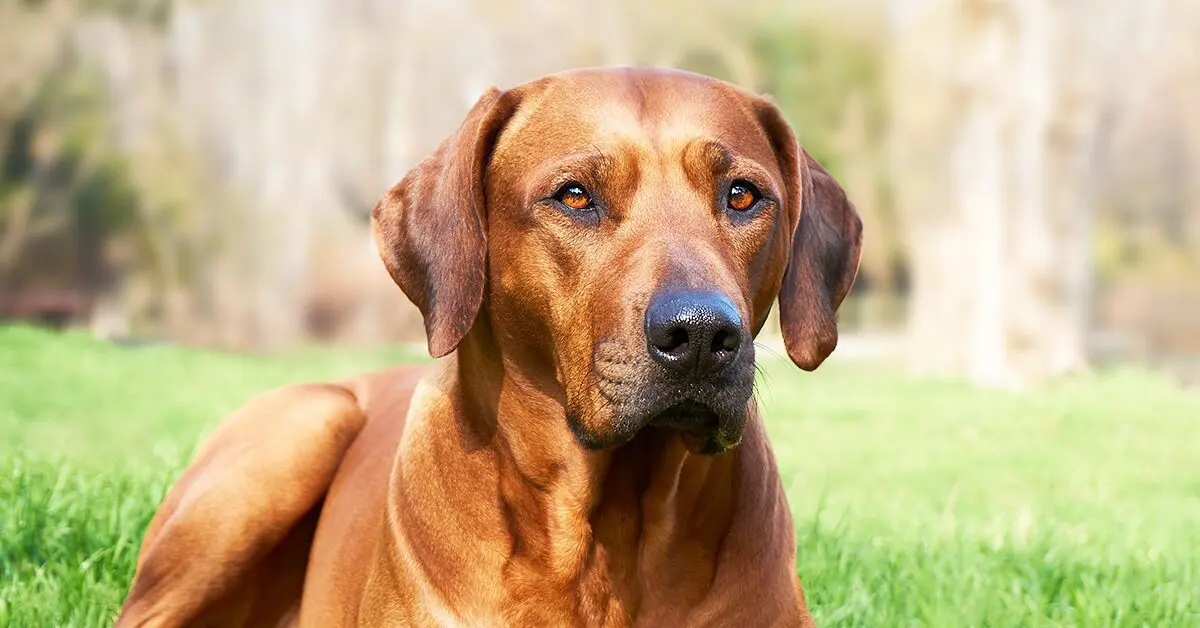
The Rhodesian Ridgeback breed is a prime example of how selective breeding can produce a dog with the desired abilities. Initially, this breed was developed out of necessity for a dog that could cope with the extreme conditions of Africa and help hunters by tracking and cornering African lion hounds. Over time, the Ridgeback has transformed from a skilled hunting partner to a loyal family pet, showcasing the breed’s versatility and lasting qualities.
Ancestry and Influences of the Breed
The Ridgeback’s ancestry combines traits from various dogs to create a breed capable of hunting and companionship. Its early use in lion hunting shows the breed’s strength and bravery. As the Ridgeback has evolved, it has retained its hunting traits while becoming a protective and affectionate family member. This transition to domestic life underscores the breed’s ability to adapt and thrive in different environments.
Beginnings in Lion Hunting
Development of Breed Characteristics
Transition to Domestic Life
Breed Ancestral Influences
The Rhodesian Ridgeback has its roots deep in the heart of Southern Africa, shaped by the region’s diverse cultures and natural environment.
This dog is a mix of the local Khoikhoi dogs and several European breeds, creating a unique animal known for its hunting skills and ability to guard. The Khoikhoi dogs were valued for their distinct back ridge and watchful nature, which, when combined with European breeds, produced a dog with the traits of sighthounds, scent hounds, and mastiffs.
In 1922, F.R. Barnes set the breed standard that still stands today. The Ridgeback’s characteristic back ridge comes from a dominant gene mutation; there is even a specific test for it.
Initially bred to hunt lions, the Rhodesian Ridgeback carries the bold spirit of its forebears.
Lion-Hunting Beginnings
The Rhodesian Ridgeback’s roots in Southern Africa gave it the agility, strength, and courage needed for lion hunting. This breed came from mixing local Khoikhoi dogs with European breeds, turning it into a skilled lion tracker.
The Ridgeback excelled in the wild and protected farmer’s homes with its daunting look and natural guarding instincts.
They require consistent training due to their intelligent but independent nature, which includes a strong will and the need for early socialization.
Evolution of Traits
The Rhodesian Ridgeback’s distinctive features have evolved through specific breeding. The breed mixes local African dogs and European breeds, creating a mighty hunter and guardian. These dogs started in South Africa, where they were crossed with Khoikhoi dogs. The Khoikhoi dogs passed down the unique ridge on their back, resulting from a dominant gene.
European breeds added endurance and strength to the mix. This combination made the Rhodesian Ridgeback a formidable lion hunter. 1922 F.R. Barnes set the breed standard to keep these valued traits intact.
Today, the Rhodesian Ridgeback is the only registered dog breed from Southern Africa, known for its loyalty and reliability.
Stature and Build of Rhodesian Ridgebacks
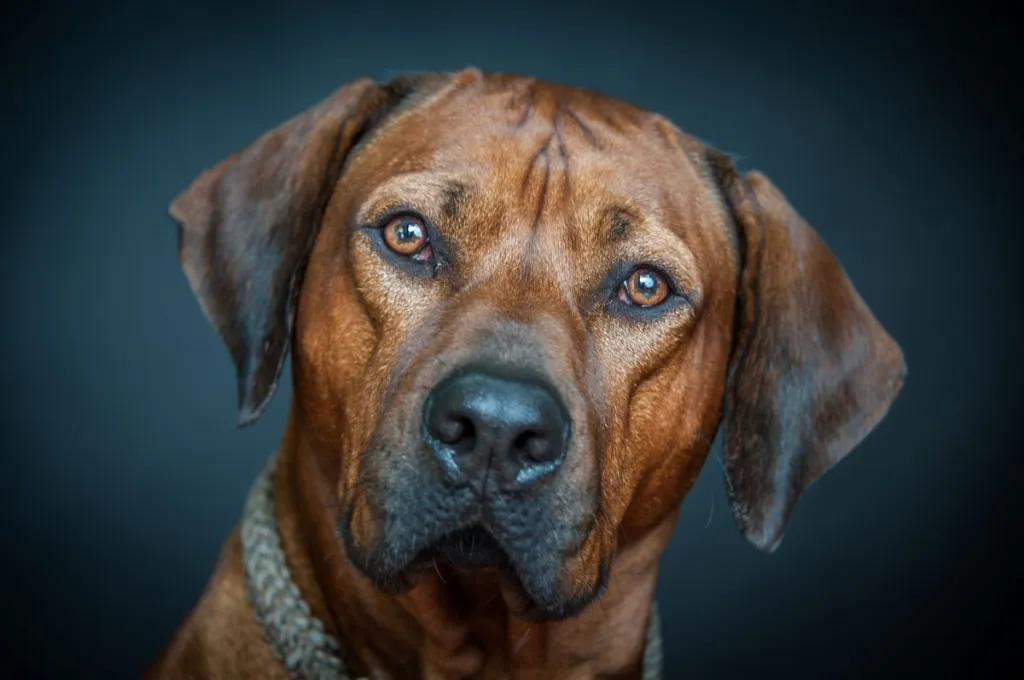
The Rhodesian Ridgeback stands out due to its unique size and physical prowess blend. A sturdy structure pairs with features that give them impressive endurance and power. It’s vital to understand these aspects thoroughly.
Here are some points to consider:
- Breed standards set the size for male and female Ridgebacks.
- Their muscular body aids their remarkable power and skill.
- Keeping Ridgebacks at an appropriate weight is vital for their well-being and functionality.
- Assessing their athletic form helps us appreciate how it supports their work and lifestyle requirements.
Typical Size Range
Rhodesian Ridgebacks are large dogs, with males standing between 25 and 27 inches at the shoulder and females ranging from 24 to 26 inches. Males typically weigh around 85 pounds, while females weigh about 70 pounds. Their size reflects the breed’s heritage as hunters and protectors.
These dogs have a muscular build and are on the larger end of the scale regarding dog sizes. Their strength and endurance make them suitable for activities that require a lot of energy, like long hunting trips or participating in dog sports.
The Rhodesian Ridgeback’s appearance is impressive and dignified, with a well-proportioned body. They have a history of being versatile, which is evident in their powerful and athletic form.
Muscular Frame Features
Rhodesian Ridgebacks are known for their muscular and robust build, a testament to their history as strong hunters and watchful guardians. These dogs have a physique that’s both practical and visually impressive.
Males often weigh about 80 pounds, while females are usually around 71 pounds. At the shoulder, males stand between 25 and 27 inches, and females stand between 24 and 26 inches. Their short, dense coat, which comes in shades from light wheaten to red wheaten, shows off their muscles and highlights the unique ridge running down their back.
These active dogs need plenty of daily exercise to keep their muscles firm and energy levels high. Their strength and instinct to protect make Rhodesian Ridgebacks excellent guard dogs. However, their independent nature means they benefit from athletics yet understand training.
Ideal Weight Guidelines
Understanding the physical characteristics of Rhodesian Ridgebacks is critical to knowing how much they should weigh to stay healthy. Male Rhodesian Ridgebacks are usually around 80 pounds and 25-27 inches tall, while females are about 71 pounds and 24-26 inches tall. Keeping their weight in check is crucial for their health and agility.
If a Rhodesian Ridgeback weighs too much or too little, it can cause health issues. Overweight dogs might develop joint problems, while underweight dogs could face malnutrition or other health concerns. Regular exercise, a well-rounded diet, and routine check-ups with a vet are essential for keeping a Rhodesian Ridgeback’s weight on track. This helps them stay healthy and active.
Athletic Physique Analysis
The Rhodesian Ridgeback boasts a sturdy and muscular body, perfect for high-energy activities. Its physique shows it’s built for both agility and lasting stamina. Male Ridgebacks stand about 24 to 27 inches tall and weigh roughly 80 pounds. Females are slightly smaller, typically measuring 24 to 26 inches and weighing nearly 71 pounds. This balance of weight and height contributes to their solid, robust build, allowing them to move swiftly and with purpose.
Their short and dense coats add to their streamlined, athletic look with a shiny overlay on their prominent muscles. The unique ridge of hair along their spine is a trademark feature and a nod to their genetic lineage.
These dogs have a high need for regular exercise. They need to stay active daily to keep up their physical form and satisfy their natural need for movement.
Growth and Development
Rhodesian Ridgebacks experience a notable growth phase that forms their solid frame and strong muscles. By the age of two, they usually reach full size. Males stand about 25-27 inches tall and weigh around 85 pounds. Females are a bit smaller, with a height of 24-26 inches and roughly 70 pounds.
Their physical development includes a thick, short coat ranging from light to red wheaten. They often have a dark mask and ears; some may have white marks on their chest and paws.
These dogs carry a gene for a pronounced ridge on their back, a breed’s hallmark. However, this genetic trait can bring about health challenges such as hip dysplasia, dermoid sinus, and degenerative myelopathy. Breeders must pay close attention to these issues to ensure the dogs stay healthy.
With proper care, Rhodesian Ridgebacks can enjoy a lifespan of 10-12 years.
Temperament Traits
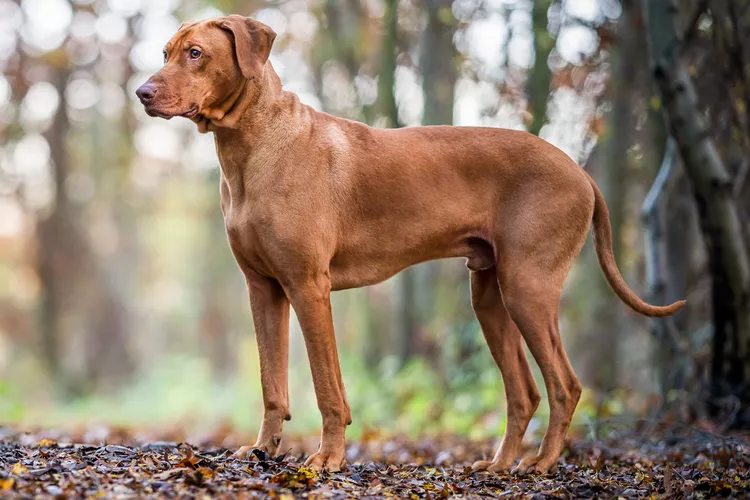
The Rhodesian Ridgeback is an intricate combination of genetic traits and the effects of their surroundings and upbringing. Understanding these aspects is crucial for anyone considering bringing one of these dogs into their home.
Here’s a clear outline of what you can expect from their behavior:
- Protective Companion: These dogs are known for their strong protective instincts towards their family members, making them excellent guard dogs.
- Self-Sufficient: They have a tendency to be independent, which may make training more of a challenge.
- Energetic and Athletic: Rhodesian Ridgebacks have a lot of energy and need plenty of exercise to keep them happy and healthy.
- Training Needs: They respond well to consistent and early training to overcome any stubborn behavior they might show.
When bringing a Rhodesian Ridgeback into your life, you must appreciate these behaviors to form a solid and positive bond with your dog.
Loyal Family Protector
Renowned for their unwavering loyalty, Rhodesian Ridgebacks are deeply committed to their families. These dogs are the epitome of a loyal family protector, always alert and emotionally connected to their humans.
Their impressive size and strong presence naturally ward off strangers, yet they’re gentle with family, kids included. Consistent training and early socialization are essential to integrate a Ridgeback well into a home.
They can be independent, so they need an owner who can lead firmly and confidently to shape a devoted guardian.
Independent Nature
Exhibiting a strong-willed and independent streak, Rhodesian Ridgebacks demand patient and consistent training from an experienced owner handling assertive breeds.
Their independent nature can manifest as a protective instinct, particularly around strangers, necessitating early and ongoing socialization to ensure a well-adjusted demeanor.
Not prone to unnecessary vocalization, Rhodesian Ridgebacks may alert their dog owners to perceived anomalies within their surroundings, serving as vigilant guardians.
The breed’s competitive spirit is evident in their performance in canine sports, where they demonstrate notable athleticism and agility.
To harness their potential, a deep and secure bond complemented by steady leadership is imperative, as these dogs thrive under guidance that respects their autonomy while steering their capabilities toward positive outcomes.
Athleticism and Energy
Rhodesian Ridgebacks are known for their solid and athletic bodies. They require regular and challenging workouts to stay fit and avoid unwanted behaviors. These dogs are great at sports like agility, tracking, and obedience, which give them the necessary mental and physical challenge.
Their stamina and zest for activity make them perfect companions for outdoor activities like jogging, hiking, or swimming.
If they aren’t given enough to do, Rhodesian Ridgebacks might start acting out. Keeping them busy with exercise and play helps prevent this. They also need ongoing training and activities that keep their minds busy to ensure they behave well and don’t get bored.
Training Requirements
Rhodesian Ridgebacks need consistent and firm training to promote positive behavior and obedience. Their natural smarts and independent streak might lead to stubbornness if they’re not guided correctly. It’s crucial to keep up with their training to help them reach their full potential and to stay in control. Early on, introducing them to different people and animals helps them get used to various situations.
If you’re new to dog ownership, you might find the sensitivity and power of a Rhodesian Ridgeback a bit overwhelming. They do best dog with someone who can handle them with calmness and patience. Never use rough methods with them; they do much better with rewards and kindness.
When Rhodesian Ridgebacks are around small children, always watch them closely. This ensures the kids stay safe and the dogs don’t get too rough.
Socialization Importance
It’s critical to know why socialization is so crucial for Rhodesian Ridgebacks. Good social habits help these dogs grow up to be friendly and well-adjusted. These puppies need to meet various people and animals from the hound group. They should also experience different places and sounds early on. This helps them build confidence and learn to adapt to new situations.
Getting a Ridgeback puppy used to different types of interactions is crucial. It helps them stay calm and behave well around others when they grow up. They might become fearful or aggressive if they don’t get this training early. But with regular contact with people and other animals, Ridgebacks learn social skills. They understand how to act around others and become great pets.
Socialization for dogs, especially for a breed like the Rhodesian Ridgeback, is essential. It helps prevent future problems and ensures they’re friendly and easy to get along with. Make sure to introduce your Ridgeback to new experiences regularly. This will help them become the perfect companion for any adventure or family setting.
Wellness Considerations for Breed Rhodesian Ridgebacks
When you have a Rhodesian Ridgeback, their health and happiness depend on a few crucial steps. Owners must be proactive in these areas:
- Regular Vet Visits: Taking your dog for check-ups can help catch and treat any health issues early on.
- Proper Feeding: A diet that suits their size and energy level will keep them in top shape.
- Enough Exercise: These dogs need plenty of activity to stay fit and happy.
- Health Care Plan: A good routine of shots, teeth cleaning, and keeping pests away is essential.
Owners must focus on their health care for the Rhodesian Ridgeback to thrive. It’s not just about regular vet visits to prevent and treat illnesses but also about giving them the right food and plenty of exercise.
This breed needs a diet that matches its activity level to stay muscular and energetic. They also need a lot of play and running to keep their minds and bodies healthy.
Lastly, a solid plan for vaccinations, dental hygiene, and pest control will shield them from common canine ailments.
Routine Health Screenings
Regular vet exams are crucial for spotting and managing health issues in Rhodesian Ridgebacks early on. These dogs are known for their unique wheaten-colored coat, and keeping them healthy involves more than just admiration for their looks. Vets often design a vaccination and preventative care plan tailored to each dog, ensuring they stay safe from prevalent illnesses and pests. It’s vital to have a heartworm prevention plan to counter the severe threat posed by this condition.
Dental health is a big part of a dog’s overall condition, so regular check-ups and professional cleaning are necessary. Keeping a Rhodesian Ridgeback at the right weight is essential, too. A balanced diet and regular exercise can prevent issues caused by obesity.
Following these steps will help keep Rhodesian Ridgebacks healthy and happy.
Diet and Nutrition
Regular health checks are crucial to spotting health problems early in Rhodesian Ridgebacks, but their diet is just as critical for their long-term health and energy. These dogs hail from Africa and need a top-quality diet for big, active dogs. Their food should fuel their high energy and support their overall well-being. It’s also vital to give them the right amount of food to avoid obesity, which can cause more health issues.
Their meals should contain lean proteins, good fats, and essential nutrients to keep their muscles strong, skin and coat healthy, and energy levels up. Always ensure they have access to clean water, especially after exercise, to keep them well-hydrated. Working with a vet to tailor a diet plan can help meet each dog’s specific health and dietary requirements.
Proper diet and hydration are fundamental for maintaining the health of Rhodesian Ridgebacks. Collaborating with veterinarians to tailor their nutrition can prevent obesity and sustain their active lifestyle.
Exercise Requirements
Rhodesian Ridgebacks are a breed with a strong hunting instinct, and they need a lot of exercise to stay healthy both in body and mind. These dogs are part of the Hound Group and have a lot of energy, so they must be active for a few hours daily.
Because they have a strong desire to chase, it’s essential to have a secure place to run freely, like a big yard with a fence.
Organized activities, such as lure coursing and agility, are great because they offer exercise and mental stimulation, which suits their instincts. Dog sports like tracking also work well for them, making the most of their ability to follow scents.
Regular training and getting along with others are vital to managing their energy and independence, which helps prevent bad behavior.
Originally Bred: Grooming and Maintenance
Caring for a Rhodesian Ridgeback’s coat and skin is vital for health. A regular grooming routine keeps the dog looking and feeling its best. Here’s how to care for a Rhodesian Ridgeback:
- Brush its coat often to minimize shedding and keep it shiny.
- Bath your dog in a way that protects its skin’s natural oils.
- Trim the nails regularly to avoid discomfort and help the dog walk easily.
- Clean its ears routinely to prevent infections.
These steps help maintain the Rhodesian Ridgeback’s good condition. Regular grooming keeps them clean and allows for early detection of any health issues.
Brushing Frequency
A weekly brushing session is essential to keep a Rhodesian Ridgeback looking its best. This helps to remove any loose hair that grows and prevents knots in their coat. Due to their short, thick fur, Rhodesian Ridgebacks need regular care to handle the hair they shed. This is especially true when seasons change, and they tend to lose more fur.
Making brushing a weekly habit does more than just tidy up your dog’s appearance. It also creates a particular time for you and your pet, strengthening your bond. For effective grooming, it’s crucial to use the right tools. A rubbing grooming mitt works excellent for picking up dead hair and spreading the dog’s natural skin oils. These oils keep the coat shiny and healthy.
Besides brushing, don’t forget the other grooming basics, like trimming nails, cleaning ears, and looking after your dog’s teeth. All these steps are essential for your Rhodesian Ridgeback’s health and comfort. Regular grooming keeps your dog happy and helps you spot any health issues early on.
Bathing Routine
Aim for a bath every 6 to 8 weeks when keeping your Rhodesian Ridgeback clean. The frequency can vary based on how much time they spend outside and their cleanliness. Their short, dense coat looks best when washed with a mild dog shampoo and conditioner. Consistency in their bathing schedule is critical to keeping their skin and coat healthy, preserving the natural oils that offer protection.
Keeping their ears clean to avoid infections is essential to grooming. Gently wiping around their eyes with a damp cloth will clear any discharge. A trim every 1 to 2 months is necessary for their nails to keep them comfortable and mobile. And don’t forget to brush them regularly using a rubber grooming mitt to cut down on shedding and maintain their coat’s condition.
Nail Care Essentials
Maintaining your Rhodesian Ridgeback’s nails is vital for their health and ease of movement. Trimming should be done every three to four weeks to prevent their nails from becoming too long, which could cause pain or other health problems.
When trimming your dog’s nails, using the right tools, like canine nail clippers or a nail grinder, is essential for a clean and safe cut. Be careful not to trim too close to the quick nail’s blood supply to avoid hurting your pet and causing bleeding.
Checking their nails for any damage, such as cracks or signs of infection, is also vital. Keeping up with nail care helps your Rhodesian Ridgeback stay active and healthy, ensuring their paws remain in good shape for their active lifestyle.
Ear Cleaning Tips
Keeping your dog’s ears clean is crucial to their health and helps prevent infections. Use vet-recommended solutions to clean the outside of the ear carefully, but stay away from the ear canal to avoid any harm.
Check their ears regularly for signs of trouble like redness, bad smells, or discharge – these could mean they need to see the vet.
For the parts of the ear you can see, gently wipe with a damp cloth or cotton ball. Don’t use cotton swabs inside their ears; it’s risky and can push dirt further in.
When cleaning your dog’s ears, give them treats and speak kindly to them. This will make them more willing to let you care for their ears next time.
Dental Hygiene Practices
Taking care of your dog’s teeth is as vital as ear care to prevent infections. Regular brushing and professional cleanings are critical to your Rhodesian Ridgeback’s dental health. To avoid plaque build-up, which can lead to tartar and gum disease, brush their teeth at least 2-3 times a week.
Incorporating dental chews and specific toys helps by physically removing plaque and tartar while your dog enjoys chewing. Regular check-ups with your vet are also essential. They can remove complex calculus and check for other problems.
Watch for signs of oral pain in your dog, like red gums or bad breath. A good diet helps maintain dental health and avoid foods that can cause dental problems.
Lion Dog Sports and Nutritional Requirements
The nutritional requirements of Rhodesian Ridgebacks are crucial for their health and vitality. A comprehensive approach to diet encompasses:
- Essential Dietary Components: A precise balance of proteins, carbohydrates, fats, vitamins, and minerals.
- Feeding Frequency Guidelines: Established patterns that align with the dog’s developmental stage and energy demands.
- Special Dietary Considerations: Tailored adjustments to address unique health issues or allergies.
- Adequate Hydration: Uninterrupted access to clean water to support metabolic processes and thermoregulation.
These points form the foundation for discussing the optimal nourishment for Rhodesian Ridgebacks.
Essential Dietary Components
High-quality protein sources like meat, fish, and poultry are essential for the diet of Rhodesian Ridgebacks. These dogs, hailing from South Africa, have a lot of energy and need food that keeps them going strong. They benefit from healthy fats, especially those with Omega-3 fatty acids in fish or flaxseed oil, which retain their skin and coat in good shape.
Complex carbohydrates from whole grains and veggies give these active dogs the energy and fiber they need for digestion. They must always have access to fresh water to stay hydrated.
A balanced diet with vitamins and minerals, such as vitamin E, C, and calcium, supports their immune system, keeps their joints healthy, and keeps them feeling great.
Feeding Frequency Guidelines
For Rhodesian Ridgebacks, a balanced diet is vital. Adult dogs do well with two meals each day, and their food should be a high-quality kibble made for large breeds with protein levels around 23-25%.
Puppy Ridgebacks must eat more often, about three to four times daily, until they are six months old. Every dog is unique, so you should consider their energy levels, metabolism, and age when deciding how much to feed them. A vet can give you advice that’s specific to your dog.
Watching your dog’s shape is essential to keep them at a healthy weight and in good condition. Using interactive toys during mealtime can keep their minds busy and help control how fast they eat.
Special Dietary Considerations
Rhodesian Ridgebacks require a diet that supports their active and athletic nature. They need the right balance of nutrients to maintain strong muscles and good endurance. They must eat food made for large, active dogs, similar to what a Great Dane would eat.
Their meals should have ingredients that support their joints, like glucosamine and omega-3 fatty acids. These can help prevent hip problems and keep their joints healthy.
It’s also important to watch for any food allergies or sensitivities. Some dogs may need a diet with fewer ingredients to avoid these issues.
To prevent bloat, a serious health risk for deep-chested dogs, they should eat smaller meals more often.
Always talk to a vet for the right food amounts and supplements, especially for growing puppies or older dogs.
